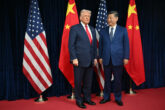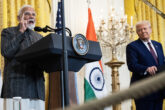August 27, 2019
In Military-Civil Fusion, China is Learning Lessons from the United States and Starting to Innovate
China’s national strategy of “military-civil fusion” (军民融合) is provoking some anxiety in Washington.1 There are concerns the United States could be challenged, or even outright disadvantaged, in technological competition relative to the more integrated approach to innovation Chinese leaders are attempting to achieve. The whole-of-nation implementation of military-civil fusion indicates the seriousness of Chinese attempts to create and leverage synergies between defense and commercial developments, particularly in emerging technologies such as artificial intelligence and biotechnology.2 It is important to recognize both the parallels and distinctions between American and Chinese concepts and approaches that can clarify the character of this competitive challenge.
China’s initiatives in military-civil fusion are informed by a close study of, and learning from, the U.S. defense industry and American defense innovation ecosystem to an extent that can be striking. In certain respects, military-civil fusion can be described as China’s attempt to imitate and replicate certain strengths from a U.S. model, but reflected through a glass darkly and implemented as a state-driven strategy.3 In this regard, American responses to the challenge of China’s ambitions in innovation ought not to envy or seek to emulate aspects of China’s model, but rather should recognize the unique strengths of its own ecosystem, while redoubling current initiatives intended to promote innovation.4 Although China’s strategy of military-civil fusion—and the powerful momentum behind merit serious scrutiny and examination, it is equally important to recognize the inefficiencies and weaknesses exhibited to date.5
Read the full article in The Strategy Bridge.
- Kathrin Hille and Richard Waters, “Washington unnerved by China’s ‘military-civil fusion,’” Financial Times, July 11, 2018, https://www.ft.com/content/8dcb534c-dbaf-11e8-9f04-38d397e6661c. ↩
- Elsa B. Kania, “Chinese Military Innovation in Artificial Intelligence,” Testimony to the U.S.-China Economic and Security Review Commission, June 2019, https://www.cnas.org/publications/congressional-testimony/chinese-military-innovation-in-artificial-intelligence. ↩
- Samuel Bendett and Elsa B. Kania, “Chinese and Russian Defense Innovation, with American Characteristics? — Military Innovation, Commercial Technologies, and Great Power Competition,” The Strategy Bridge, August 2, 2018, https://thestrategybridge.org/the-bridge/2018/8/2/chinese-and-russian-defense-innovation-with-american-characteristics-military-innovation-commercial-technologies-and-great-power-competition. ↩
- “China’s Threat to American Government and Private Sector Research and Innovation Leadership,” Testimony before the House Permanent Select Committee on Intelligence, July 19, 2018, https://www.cnas.org/publications/congressional-testimony/testimony-before-the-house-permanent-select-committee-on-intelligence ↩
- For a helpful and authoritative assessment of the strengths and weaknesses of Chinese industrial policy and implementation of military-civil fusion, see: Greg Levesque, “Testimony before the U.S.-China Economic and Security Review Commission Hearing on What Keeps Xi Up at Night: Beijing’s Internal and External Challenges,” February 7, 2019, https://www.uscc.gov/sites/default/files/Levesque_USCC%20Testimony_Final_0.pdf. ↩
More from CNAS
-
Indo-Pacific Security / Energy, Economics & Security
How to Win the Economic War with ChinaTrump's approach to China has run aground, giving Beijing unprecedented advantage in the economic conflict....
By Edward Fishman & Julian Gewirtz
-
America’s Self-Loathing Is a Losing Hand
This article was originally published in The Washington Post.Around 10 years ago, the United States began a historic shift in its grand strategy toward China, abandoning the b...
By David Feith
-
Indo-Pacific Security / Energy, Economics & Security / Technology & National Security
Selling AI Chips Won’t Keep China Hooked on U.S. TechnologyU.S. policy should not rest on the illusion that selling chips can trap China inside the American tech ecosystem....
By Janet Egan
-
Will New Delhi-Beijing Move Beyond Friction Points? | Ex-White Official On India-China Reset
Prime Minister Narendra Modi on Friday said that India and China, as two major economies, must work together to bring stability to the global economic order. NDTV's Gaurie Dwi...
By Lisa Curtis




